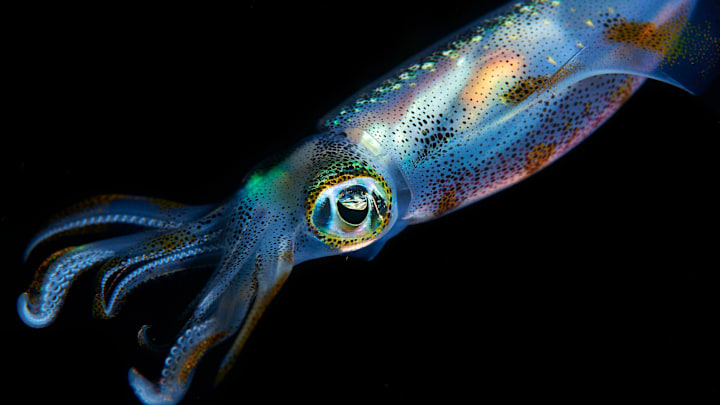Most people can recognize a squid, even if they’ve only seen the cartoon version on Spongebob Squarepants. Cuttlefish may be less well known but are equally armed and fabulous. They're found in oceans all over the world, and both belong to the class Cephalopoda, Greek for “head-foot”—an apt description of their physiques.
Here are some of the reasons they’re mistaken for each other—and how to tell them apart.
Shapes and Sizes
Most squid species have a torpedo-shaped body, called a mantle, supported by an internal shell known as a gladius or pen. It’s pointy on one end and flared at the other, and it protects the animal’s internal organs. Squids also have eight arms with suckers on the undersides and two longer tentacles, which are used to grab prey.
More than 300 known species of squid display incredible variety in their appearance. The recently documented Ryukyuan pygmy squid (Idiosepius kijimuna) and Hannan’s pygmy squid (Kodama jujutsu) are just a half-inch long, while specimens of giant squid (Architeuthis dux) have measured nearly 60 feet long and weighed over a ton.

Cuttlefish resemble compressed squids. They have shorter, blunt mantles and a frill of undulating fin all around it, as well as shorter arms and tentacles. Their internal shell is called a sepion or cuttlebone, which those with pet birds will recognize as a healthful treat for parakeets. Cuttlebone is made of aragonite, a porous form of calcium carbonate, and helps the animal maintain buoyancy and protects its organs.
The smallest of the roughly 120 species of cuttlefish is the 3-inch-long Pfeffer’s flamboyant cuttlefish (Metasepia pfeferi). The tiny cephalopod can change its color and shape to resemble its surroundings, but divers should beware: it’s the only venomous species of cuttlefish. On the other end of the scale, the giant Australian cuttlefish weighs up to 22 pounds and measures about 1.5 feet long.
Sophisticated Eyes
Both cuttlefish and squid are a bit wild-eyed—but in different ways. Cuttlefish have a W-shaped pupil that allows them to see different wavelengths of polarized light, so that they can distinguish colors without having dedicated photoreceptors. They can also swivel their eyes forward and backward to achieve accurate depth perception.

Squid eyes are highly adapted to see light in the gloomy depths of the ocean, and their vision has almost the same resolution as humans’. Giant squids and colossal squids (Mesonychoteithis hamiltoni) have the largest eyes on Earth, measuring roughly 12 inches in diameter—about the size of a basketball.
Masters of Disguise
Cuttlefish and squid are masters of camouflage thanks to the chromatophores in their skin. The animals can make these tiny, pigment-filled sacs expand and contract, thus changing the colors and patterns they display for camouflage or hunting. They may mimic the coral reefs and substrate in their environment to hide in plain sight, or squish their bodies into small spaces so predators will overlook them.
Cuttlefish also hypnotize prey with a continuous loop of their changing colors, making it a lot easier for the animals to snag small fish, crustaceans, or worms. While cuttlefish shoot their tentacles out from a tucked-up position in lightning-fast bursts to grab a meal, squid grasp prey in their tentacles and bring it into their arms, and then into their mouths, where they use their radula (a kind of sharp, serrated tongue) to rip it apart.
Defenses Against Danger
Squid and cuttlefish can move quickly by filling a cavity inside their mantle (the main part of their bodies) with water, and then shooting it out with enough force to send the animal rocketing in the other direction.

Both will squirt clouds of ink, partly made of melanin, to confuse attackers and use that jet propulsion to make a quick getaway. Some squid can even get airborne with this technique: they jet right out of the ocean and can propel themselves as much as 90 feet through the air.
Read More Fascinating Facts About Ocean Animals:
